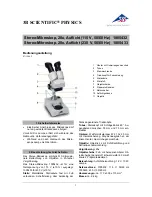
10
7. Köhler illumination (Fig. 7)
The Köhler illumination is the optimal microscopic illumination
and therefore standard for scientific research and micropho-
tography. One gets it using the fixed field diaphragm and the
height- and center-adjustable Abbe condenser:
a) Using the condenser up-down knob (1), move the conden-
ser (Fig. 3, No. 8) to the highest position, right under the
stage.
b) Turn on the power switch (3) and focus the object.
c) Shut the field diaphragm (5) as close as possible. If the
image of the field diaphragm lies out of the field of view,
move it into the field using the condenser centering screws
(6).
d) Using the condenser up-down knob (1), change the height
of the condenser, until the image of the field diaphragm is
clear.
e) Using the condenser centering screws (6), center the image
of the field diaphragm in the field of view.
f) Open the field diaphragm so widely, that its edge has only
just left the field of view and this field is complete illumi-
nated. It may be, that you have to center the condenser a
little bit again. Now, adjust the aperture diaphragm, which
is described in the next paragraph.
8. Aperture diaphragm (Fig. 8)
Fig. 8
The aperture diaphragm lever (Fig. 7, No. 4) can be turned in
order to open or close the aperture diaphragm. Remove the
eyepieces and watch through the eyepiece tube. For cente-
ring, the condenser centering screws (Fig. 7, No. 6) are used
when the diaphragm image is eccentric with the objective
pupil (1). Turn the aperture diaphragm lever for getting a good
resolution and contrast perception. Usually, the diameter of
the aperture diaphragm image (2), which has to be adjusted,
is 70-80 percent of the objective pupil.
9. Exchange of the lamp (Fig. 9)
a) Switch off the power switch and pull out the plugs of the
AC-adapter from mains socket and from mains in at the
microscope (Fig. 2, No. 7).
b) Incline the microscope, loose the fixing screw (3) of the
lamp door on the middle part of the bottom and open the
lamp door; so, you remove the lamp baseboard (1) from
the bottom.
c) Pull out the old lamp (4) from the lamp base (5). Be careful,
as the lamp may be hot!
d) Insert the new lamp (4) into the lamp base (5). Notice the
properly touching; take care not to touch the lamp with
bare fingers. E. g., use the protective envelope of the lamp
or a tissue, in order to grasp the bulb.
e) Reinstall the lamp door (1) with lamp base board (5) on the
bottom with the screw (3).
f) After mounting the lamp well, plug in the power cord, turn
on the power switch, turn the objective lens into the light
path, adjust the condenser upwards and downwards, and
make light enter the view field. If the light spot is offset from
the center of view, loose the screw (2) slightly and move
the lamp base (5). Move the lamp spot into the center, then
tighten up the screw (2) immediately.
Fig. 9
V. MAINTENANCE
1. Sweep the lens
Sweep the lens by lens tissue or soft fabric immersed with
a mixed liquid of alcohol/ether. Clean the 100x oil objective
from oil whenever you finish operating.
2. Clean the painted parts
The dust on the painted parts can be removed by gauze.
For the grease spots, the gauze immersed slightly with
aviation gasoline is recommended. Do not use organic
solvents such as alcohol, ether or other thinner etc. for
cleaning the painted parts or plastic components.
3. Avoid disassembling the microscope
Because of being a precise instrument, do not disassemble
the microscope casually. That may cause serious damage
to its performance.
4. Being not used
Cover the microscope with the dust cover (made of po-
lymethylmethacrylate or polyethylene) and place it there,
where it is dry and mouldless. We suggest the storage
of all objectives and eyepieces in a closed container with
drying agent.
B C
70-80 %
D
B
D
E
C
F

































